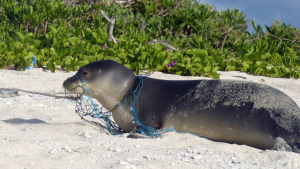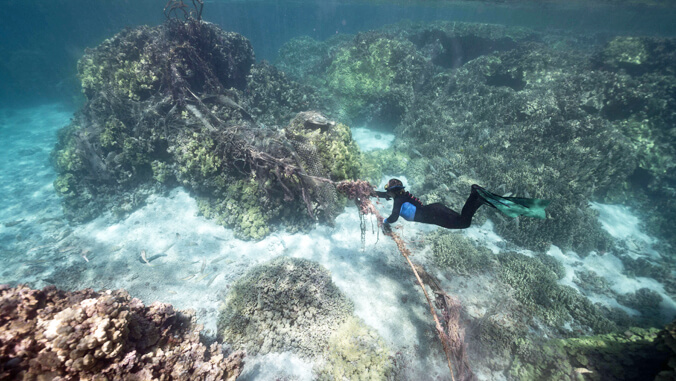Endangered Hawaiian monk seals and other marine life have benefitted from 25 years of large-scale marine debris removal in the Northwestern Hawaiian Islands (NWHI), according to the cover story in the current issue of Science.

Scientists from NOAA Fisheries Pacific Islands Fisheries Science Center (PIFSC) have been studying the devastating impacts of plastic pollution on marine mammals, sea turtles, fish and coral reefs for more than 40 years. To reduce harm to Hawaiian monk seals, as well as the broader marine ecosystem, large-scale, multi-agency, and multi-partner marine debris removal efforts were initiated to decrease impacts of plastic marine debris, primarily abandoned, lost and discarded fishing gear.
A team of researchers from PIFSC, the Papahānaumokuākea Marine Debris Project, and the University of Hawaiʻi Sea Grant College Program (Hawaiʻi Sea Grant) examined Hawaiian monk seal entanglement records spanning more than 40 years, both before and after large-scale removal efforts were initiated, and found a substantial reduction in the rate of entanglement where the debris removal effort was most concentrated.
Jason Baker, marine biologist with the NOAA PIFSC Protected Species Division and lead author on the study, said "Now we know that all the hard work and dedication of so many people and organizations that contributed to the Northwestern Hawaiian Islands marine debris cleanup did achieve its aim of reducing monk seal entanglement, saving seal lives and improving nearshore habitats."

Mary J. Donohue, affiliate faculty with Hawaiʻi Sea Grant and co-author on the study, has spent her career researching the devastating impacts of plastic pollution on marine mammals and coral reefs. In Hawaiʻi she served as chief scientist on the first systematic at-sea expeditions to document, study, and remove marine debris from the NWHI.
"We've shown that you can, in fact, clean up at least parts of the ocean, and it can be consequential, particularly for species of conservation or cultural concern," said Donohue. "For lasting solutions we also need to reduce the input of fishing gear that becomes derelict, both from legal and illegal fisheries."
The team's work—"Four decades of Hawaiian monk seal entanglement data reveal the benefits of plastic debris removal"—is available online beginning September 26 and in print on September 27.
Plastic waste poses a triple threat to living organisms and the environment: the physical material itself, the chemicals associated with it, and disease-causing microorganisms that hitchhike on it. The longevity of plastic waste and its fragmentation results in impacts on multiple scales, from marine mammal entanglement in derelict fishing gear to tissue and cellular interactions with the tiniest nanoplastics. As stated in the paper, "Large-scale and sustained removal of abandoned, lost, or otherwise discarded fishing gear meaningfully benefits marine ecosystems and has the potential to be transformational in restoration efforts."







